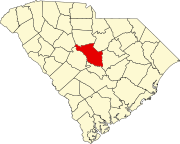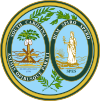Columbia, South Carolina
Columbia, South Carolina | |
|---|---|
 | |
| Nickname(s): "The Capital of Southern Hospitality" (Official), "The Big Friendly" | |
 | |
| Coordinates: 34°00′N 81°02′W / 34.000°N 81.033°W | |
| Country | |
| State | |
| Counties | Richland |
| Approved | March 22, 1786 |
| Chartered (town) | 1805 |
| Chartered (city) | 1854 |
| Named for | Columbia |
| Government | |
| • Mayor | Daniel Rickenmann (R) |
| Area | |
| • Total | 136.78 sq mi (354.3 km2) |
| Elevation | 314 ft (96 m) |
| Population (2021) | |
| • Total | 137,541 |
| • Density | 998.9/sq mi (385.7/km2) |
| Time zone | UTC-5 (EST) |
| • Summer (DST) | UTC-4 (EDT) |
| Area codes |
|
| FIPS code | 45-16000 |
| GNIS feature ID | 423587, 428803 |
| Website | https://www.columbiasc.gov/ |
Columbia is the state capital and the second most populous city in the U.S. state of South Carolina. As of the 2020 Census, it has a population of 137,300[1] as compared to Charleston, South Carolina, with 151,612.
It is the county seat of Richland County, but a small portion of the city is in Lexington County. It is home to the University of South Carolina.
Just east of the city is Fort Jackson, the U.S. Army's largest and most active initial entry training installation,[2]
History[change | change source]
Columbia is on the fall line from the Appalachian Mountains. The fall line is the spot where boats cannot travel any farther upstream and is also the spot farthest downstream where falling water can usefully power a mill.
The state capital before 1790 was Charleston on the coast of the Atlantic Ocean. In 1786, the legislature decided to move the money to the state's center. The site of Columbia was chosen for its location on the river just 13 miles (21 km) northwest of South Carolina's geographic center. The State Legislature first met there in 1790. After remaining under the direct government of the legislature for the first two decades of its existence, Columbia was incorporated as a village in 1805 and then as a city in 1854. Columbia received a significant stimulus to development when it was connected in a direct water route to Charleston by the Santee Canal. This canal connected the Santee and Cooper Rivers in a 22-mile (35 km) section. It was first chartered in 1786 and completed in 1800, making it one of the earliest canals in the United States. With increased railroad traffic, it ceased operation around 1850.
Columbia was one of the first planned cities in the United States. It is known for its wide streets.

After Sherman's March to the Sea the Union Army attacked and occupied Columbia, an important military center. On February 17, 1865, a fire destroyed much of the city and killed many people.
The 20th century saw Columbia emerge as a regional textile manufacturing center. In the 1920s, Columbia business people constructed a large dam on the Saluda River to make hydroelectric power.[3] The dam, using the native red clay soil and bedrock, was the largest earthen dam in the world when it was completed in 1930. Lake Murray, formed by the dam, is 41 mil, es (66 km) long and 14 miles (23 km) wide at its widest point. When the lake was finished, it was the world's largest artificial reservoir. The company built the dam grew to become SCANA Corporation, one of Columbia's largest employers.[4]

The city of Columbia has recently accomplished several redevelopment projects and has several more planned.[5] The historic Congaree Vista, a 1,200-acre (5 km2) district running from the central business district toward the Congaree river, features several historic buildings that have been rehabilitated.
Transportation[change | change source]
The Central Midlands Regional Transit Authority (CMRTA), operates mass transit in the greater Columbia area including Cayce, West Columbia, Forest Acres, Arcadia Lakes, Springdale, and the St. Andrews area. CMRTA operates express shuttles and bus services serving Columbia and its immediate suburbs. The authority was established in October 2002 after SCANA released ownership of public transportation back to the City of Columbia. Since 2003, CMRTA has provided transportation for more than 2 million passengers, expanded route services, and introduced 43 new ADA-accessible buses offering safer, more comfortable transportation. CMRTA has also added ten natural gas-powered buses to the fleet.
The Central Midlands Council of Governments is investigating the potential for rail transit in the region. Routes into downtown Columbia originating from Camden, Newberry, and Batesburg-Leesville are in consideration, as is a potential line between Columbia and Charlotte connecting the two main lines of the future Southeastern High-Speed Rail Corridor.[6]
Columbia's central location between the population centers of South Carolina has made it a transportation focal point with three interstate highways and one interstate spur.
The city and its surroundings are served by Columbia Metropolitan Airport (IATA:CAE; ICAO:KCAE). The city is served daily by Amtrak and Greyhound Lines buses.
Education[change | change source]
Columbia has the main campus of the University of South Carolina, chartered in 1801 as South Carolina College and in 1906 as the University of South Carolina. The university has 350-degree programs and enrolls more than 27,500 students throughout 15 degree-granting colleges and schools. It is an urban university in downtown Columbia, just south of the Capitol.
Other colleges are Allen University, Benedict College, Columbia College, Columbia International University, Lutheran Theological Southern Seminary, and Midlands Technical College.
Counties[change | change source]
Metropolitan[change | change source]
Micropolitan[change | change source]
References[change | change source]
- ↑ "U.S. Census Bureau QuickFacts: Columbia city, South Carolina". www.census.gov. U.S. Government. Archived from the original on June 10, 2022. Retrieved June 10, 2022.
- ↑ Fort Jackson South Carolina Archived June 16, 2010, at the Wayback Machine. Jackson.army.mil. Retrieved September 29, 2010.
- ↑ "Lake Murray History". iData Technologies. Archived from the original on October 10, 2011. Retrieved November 26, 2011.
- ↑ "The World's Greatest Earthen Dam". SCE&G. Retrieved November 26, 2011.
- ↑ Archives - Selling the North Columbia TIF, City Council Members Push On Archived July 11, 2011, at the Wayback Machine. Free Times (January 26, 2010). Retrieved 2010-09-29.
- ↑ Rail Transit Study[permanent dead link]



